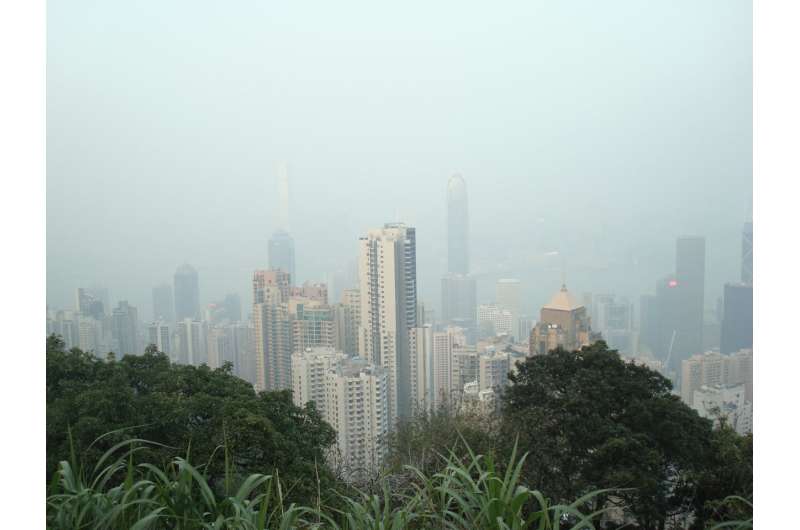This article has been reviewed according to Science X's editorial process and policies. Editors have highlighted the following attributes while ensuring the content's credibility:
fact-checked
proofread
Study: Long-term exposure to air pollution, lack of green space increase hospitalization risk for respiratory conditions

Long-term exposure to air pollution and a lack of access to green spaces increase the risk of hospitalization for respiratory conditions, according to a study presented at the European Respiratory Society (ERS) Congress in Vienna, Austria.
Traffic-related air pollution is also strongly linked to the progression from asthma to asthma-COPD, according to a second study also presented at the ERS Congress.
Previous research has linked air pollution to an increase in respiratory conditions such as asthma and chronic obstructive pulmonary disease (COPD), and access to parks and gardens to a decrease; however, less is known about the long-term effects of air pollution on respiratory hospitalizations, and whether air pollution makes people who already have asthma more likely to develop COPD.
The first study, the results of the Life-GAP project, were presented by Ms. Shanshan Xu from the Department of Global Public Health and Primary Care, University of Bergen, Norway.
Her team used the results of northern European study centers from the European Community Respiratory Health Survey which covered respiratory hospitalizations from 2000 to 2010.
The study looked at 1644 people from five countries. They evaluated the association between respiratory health and long-term exposure (between 1990 and 2000) to particulate matter, black carbon, nitrogen dioxide, ozone, and greenness (the amount and health of vegetation surrounding a person's home).
Although Northern Europe has relatively low air pollution levels, they found that particulate matter, black carbon, and nitrogen dioxide increased the risk of being hospitalized for respiratory diseases in this population.
Ms. Xu explained, "Specifically, we observed that for each interquartile range increase in these pollutants, the risk of hospitalization rises by approximately 30 to 45%, depending on the pollutant. Greenness, on the other hand, contributed to a reduced risk of respiratory hospitalization."
But while greenness was associated with a decreased risk of respiratory hospitalizations, it was also linked to an increased number of respiratory emergency room visits, particularly when looking at the co-presence of hay fever.
Ms. Xu added, "Air pollution causes persistent inflammation and oxidative stress in the respiratory system. These harmful processes contribute to the development and exacerbation of chronic respiratory diseases, which can escalate into severe health episodes requiring hospital care.
"It is also likely that long-term exposure to air pollution could lead to a decreased tolerance or increased sensitivity to these pollutants, explaining why even moderate or low levels might cause severe health effects in certain populations."
The second study was presented by Dr. Samuel Cai from the Center for Environmental Health and Sustainability at the University of Leicester, UK.
The study looked at 46,832 participants with asthma who were recruited into the UK Biobank cohort during the years 2006-2010. Levels of two main air pollutants—particulate matter and nitrogen dioxide—were estimated at each participant's home address, and a genetic risk score (based on each individual's genetic make-up for the potential of developing both asthma and COPD) was calculated for each participant. The team then quantified the impact of both air pollution and genetic scores on the incidence of COPD among asthmatics.
Dr. Cai explains, "We found that for every 10 micrograms per meter cubed higher exposure to particulate matter, the risk of developing COPD was 56% higher among asthmatic patients; we also found that higher exposure to nitrogen dioxide increases the risk. In addition, if individuals carry a medium-to-high genetic risk score, the risk of increased nitrogen dioxide exposure causing asthma to progress to COPD is even higher."
Dr. Cai adds, "People with asthma should always be aware of air pollution around them and, if necessary and resources allow, take measures such as wearing masks, use an indoor air purifier and reducing outdoor activities when air pollution is at high levels."
Zorana J Andersen is Chair of the ERS Health and Environment Committee, and Professor of Environmental Epidemiology at the Department of Public Health, University of Copenhagen, Denmark, and was not involved in the research.
She said, "These findings emphasize the critical impact of long-term exposure to air pollution on respiratory health and highlight the need for effective clean air initiatives and regulations.
"Air pollution affects everybody, but most people are very limited in the actions they can take against it to protect their health. It falls to policy-makers to come up with some bold actions to tackle air pollution in our cities and help everyone, including those with asthma. This includes initiatives to reduce pollution and promote urban greenery, as well as thoughtful urban planning that avoids planting allergenic vegetation.
"We also need to find ways not only to prevent the onset of asthma, but to prevent it from developing into a multi-disease state in the long-term, as this presents a great burden not only on patients, but also on the health care system."

















